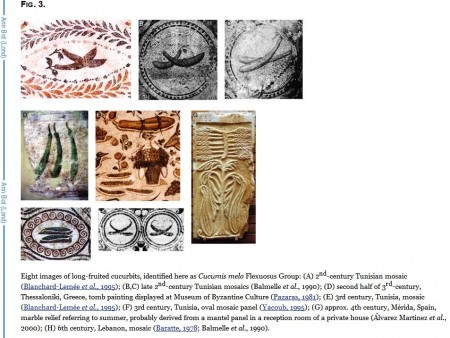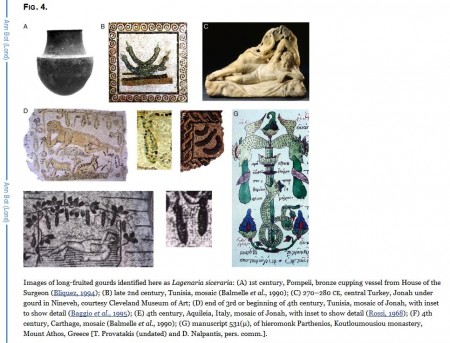- Climate and Food Production: Understanding Vulnerability from Past Trends in Africa’s Sudan-Sahel. Investment in smallholder farmers can reduce vulnerability, it says here.
- An evaluation of the effectiveness of a direct payment for biodiversity conservation: The Bird Nest Protection Program in the Northern Plains of Cambodia. It works, if you get it right; now can we see some more for agricultural biodiversity?
- Finger millet: the contribution of vernacular names towards its prehistory. You wouldn’t believe how many different names there are, or how they illuminate its spread.
- Genome-Wide Association Studies. How to do them. You need a platform with that?
- Revisiting the sequencing of the first tree genome: Populus trichocarpa. Why to do them.
- Exogenous plant MIR168a specifically targets mammalian LDLRAP1: evidence of cross-kingdom regulation by microRNA. “…exogenous plant miRNAs in food can regulate the expression of target genes in mammals.” Nuff said. We just don’t understand how this regulation business works, do we.
- Anatomical enablers and the evolution of C4 photosynthesis in grasses. It’s the size of the vascular bundle sheath, stupid!
- Land administration for food security: A research synthesis. Administration meaning registration, basically. Can be good for smallholders, via securing tenure, at least in theory. Governments like it for other reasons, of course. However you slice it, though, the GIS jockeys need to get out more.
- Genetic Analysis of Visually Scored Orange Kernel Color in Maize. It’s better than yellow.
- Comment on “Ecological engineers ahead of their time: The functioning of pre-Columbian raised-field agriculture and its potential contributions to sustainability today” by Dephine Renard et al. Back to the future. Not.
- Environmental stratifications as the basis for national, European and global ecological monitoring. Bet it wouldn’t take much to apply it to agroecosystems for agrobiodiversity monitoring.
- Use of Contingent Valuation to Assess Farmer Preference for On-farm Conservation of Minor Millets: Case from South India. Fancy maths suggests farmers willing to receive money to grow crops.
- Wild food plant use in 21st century Europe: the disappearance of old traditions and the search for new cuisines involving wild edibles. The future is Noma.
- Population genomic and genome-wide association studies of agroclimatic traits in sorghum. Structuring by morphological race, and geography within races. Domestication genes confirmed. Promise of food for all held out.
- Response of Sorghum to Abiotic Stresses: A Review. Ok, it could be kinda bad, but now we have the above, don’t we.
- Genetic resources: the basis for sustainable and competitive plant breeding. In Brazil, that is.
- A nuclear phylogenetic analysis: SNPs, indels and SSRs deliver new insights into the relationships in the ‘true citrus fruit trees’ group (Citrinae, Rutaceae) and the origin of cultivated species. SNPs better than SSRs in telling taxa apart. Results consistent with taxonomic subdivisions and geographic origin of taxa. Some biochemical pathway and salt resistance genes showing positive selection. No doubt this will soon lead to tasty, nutritious varieties that can grow on beaches.
Banter about cucurbits
Mary Beard, classics professor at Cambridge and effective general-purpose public intellectual, knows how to get your attention:
Sikyonians … were a sort of Greek footwear, but also a famous variety of cucumber and so a comic term for a phallus, and the ‘scarlets’ are a suspicious match for the scarlet dildo…
That’s from a review, enticingly entitled Banter about Dildoes, 1 of a book on Roman shopping with a much more boring title. 2 Well, I defer to Prof. Beard on Greek footwear and Roman sex toys, but I’m not so sure about that cucumber.
To see why, let’s turn to a 2007 Annals of Botany paper The Cucurbits of Mediterranean Antiquity: Identification of Taxa from Ancient Images and Descriptions, by Jules Janick et al.:
Many of the Renaissance botanists identified the cultivated sikyos of the Greeks as cucumber. Observers of more recent times, including de Candolle (1886), Sturtevant (Hedrick, 1919) and Hyams (1971), have concurred. However, as de Candolle (1886) admitted, the origin of cucumbers is the foothills of the Himalayas. Although Roberts (2001) identified two ancient mosaic images as depicting cucumber (see Figs 3E and and 4B) the former is clearly Cucumis melo, as evidenced by the longitudinal split in the fruit, and the latter is Lagenaria siceraria, as evidenced by the obviously swollen peduncular ends of the fruits. Archaeobotanical records include findings of several seeds purportedly of cucumber, but it is extremely difficult, even for experts, to differentiate between the seeds of C. sativus and C. melo (Bates and Robinson, 1995). Possibly, an identification of the species of these seeds could be accomplished by analysis of ancient DNA (Gyulai et al., 2006). In this survey of Mediterranean iconography and verbal sources of Roman times, we have found no hard evidence of the presence of cucumbers. There is some linguistic evidence that they became known in the region during the early Middle Ages (Amar, 2000) but the earliest European image known to us of what can be unquestionably identified as cucumber is from approx. 1335, post-dating the Mongol invasions. Renaissance depictions of cucumbers, although very common, show much less variation than do those of melons, which is suggestive of their being more recently introduced or of their lesser culinary appreciation or economic importance.
I think it is worth reproducing those mosaic images. Hopefully Annals of Botany won’t mind. Here’s 3E, the slitty Cucumis melo.
And here’s 4B, the knobby Lagenaria.
So, one can understand the mistake, but, pace Prof. Beard, that “famous variety of cucumber” was probably a famous variety of something else, either a muskmelon 3 or a bottle gourd. Though, as you can see from the illustrations, 4 that wouldn’t affect its comic potential. On the contrary…
PS Incidentally, since we’re talking funny-shaped cucurbits in history…
Nibbles: Mashua info, Veggies programme, Rice research, Genomes!, Indian malnutrition, Forest map, British agrobiodiversity hero, GMO “debate”, Lactose tolerance, Beer
- New Year Resolution No. 1: Take the mashua survey.
- New Year Resolution No. 2: Give the Food Programme a break, it can be not bad. As in the case of the recent episode featuring Irish Seed Savers and the only uniquely British veg.
- New Year Resolution No. 3: Learn to appreciate hour-plus talks by CG Centre DGs. And other publicity stunts…
- New Year Resolution No. 4: Give a damn about the next genome. Well, actually…
- New Year Resolution No. 5: Try to understand what people think may be going on with malnutrition in India. If anything.
- New Year Resolution No. 6: Marvel at new maps without fretting about how difficult to use they may be.
- New Year Resolution No. 7: Do not snigger at the British honours system.
- New Year Resolution No. 8: Disengage from the whole are-GMOs-good-or-bad? thing. It’s the wrong question, and nobody is listening anyhow.
- New Year Resolution No. 9: Ignore the next lactose tolerance evolution story. They’re all the same.
- New Year Resolution No. 10: Stop obsessing about beer. But not yet. No, not yet.
- Happy 2013!
Nibbles: Breeding, Real farmers, Plant clinics, Nutrition research, Beer futures, Mexican spices
- The Campaign for Real Farming raves about a rant on open breeding.
- Steve Savage counters with a rant against raving food movement loonies.
- CABI opens plant clinics in China, thousands more on the way worldwide.
- A paper on Guiding principles for operational investments to prioritise nutrition in agriculture and rural development projects.
- What 2013 holds for beer and beer lovers.
- What can you tell Rachel Laudan about spices in Mexico and the Columbian Exchange?
The history of the tomato
One reason to love the internets, back into which, fully refreshed, we plunge, is this comment:
[T]he plant Galen mentions is the λυκοπέρσιον, lykopersion, not lykopersikon. The name means ravager or slayer of wolves, like our wolfsbane. The transition to the “wolf-peach” happened sometime later, probably a scribe’s error. Liddell-Scott’s Greek-English Lexicon describes it as an Egyptian plant with strong-smelling, yellowish juice and identifies it as Hyoscyamus muticus, one of the very poisonous, tropane-bearing Solanaceae. There are plenty of other seriously deadly Solanaceae in Egypt but this is as good a guess as any.
That’s from Pat the Plant 5 in response to this (very familiar) bit in a long and fascinating post about the tomato from Hollis at In the Company of Plants and Rocks.
“Lycopersicum” means “wolf peach”, and probably was selected by Linnaeus from the classical literature. Lycopersicon was a plant described by the Roman physician Galen as being both delicious and dangerous — appropriate for the tomato during Linnaeus’s time (see discussion below). No one has figured out what Galen’s lycopersicon actually was, and there’s no reason to think it was the tomato of the Americas, given that he lived in Europe during the second century AD. (“Wolf peach” is sometimes attributed to German were-wolf legends, for example here).
I found Hollis’ post, somewhat belatedly, via the latest Berry go Round, hosted by Susannah at On the other hand. Being partly responsible for BGR, I feel bad that it has been a little hit and miss lately, and glad that Susannah is going to feed and water it going forward until it is once again bursting with the best botany blogging the internets can offer. Why not submit your own work?

